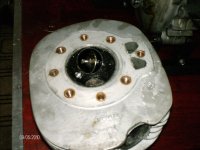Hi Guys
Massive thanks to Andy Monty for posting the timing tool instructions way back in 2015.
Just going through this myself with my 1.4 petrol Qubo with the 350A1000 VVT engine after a head gasket failure. Made and fitted a cam locking tool and a flywheel ring gear locking tool to lock the crankshaft before removing the belt and the head. I didn't remove the cam pulley and refitted the head with my cam locking tool in place and the ring gear lock (still) in place, and the cambelt went back on a treat.
Got rough running / hunting when I started the engine. Finally got some diagnostics hooked up which reported the cam timing being out. Having read further with much help from BugsyMike, the only logical explanation is that the camshaft pulley has moved relative to the cam whilst the head was disassembled, and / or the cam position sensor is misaligned.
The infuriating thing is that I had done the cambelt without any tools and without any problems about 2000 Miles before. I guess the cam sprocket simply didn't have the opportunity to move relative to the cam in the short time the belt was off.
Sourced a locking kit which came without any instructions but it looks very much like the kit Andy had. Going for 'take 2' today and will post the results and any tips I find.
Qubo Pete
Massive thanks to Andy Monty for posting the timing tool instructions way back in 2015.
Just going through this myself with my 1.4 petrol Qubo with the 350A1000 VVT engine after a head gasket failure. Made and fitted a cam locking tool and a flywheel ring gear locking tool to lock the crankshaft before removing the belt and the head. I didn't remove the cam pulley and refitted the head with my cam locking tool in place and the ring gear lock (still) in place, and the cambelt went back on a treat.
Got rough running / hunting when I started the engine. Finally got some diagnostics hooked up which reported the cam timing being out. Having read further with much help from BugsyMike, the only logical explanation is that the camshaft pulley has moved relative to the cam whilst the head was disassembled, and / or the cam position sensor is misaligned.
The infuriating thing is that I had done the cambelt without any tools and without any problems about 2000 Miles before. I guess the cam sprocket simply didn't have the opportunity to move relative to the cam in the short time the belt was off.
Sourced a locking kit which came without any instructions but it looks very much like the kit Andy had. Going for 'take 2' today and will post the results and any tips I find.
Qubo Pete




